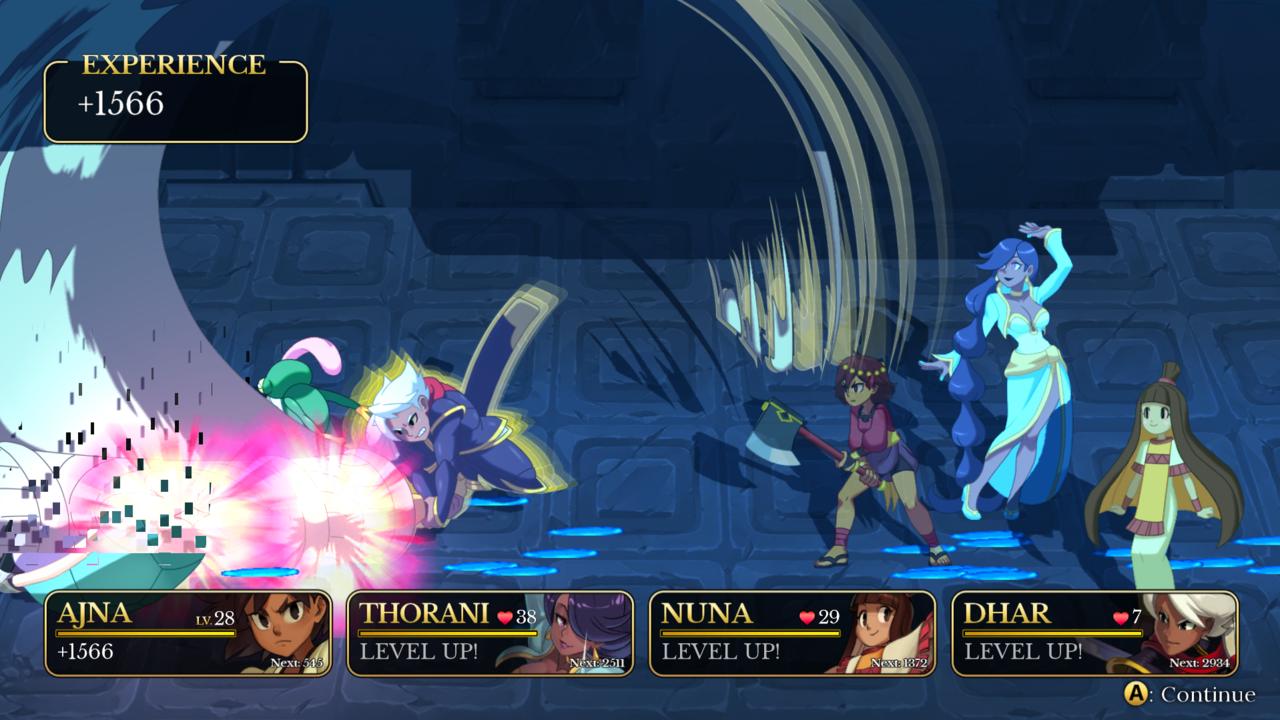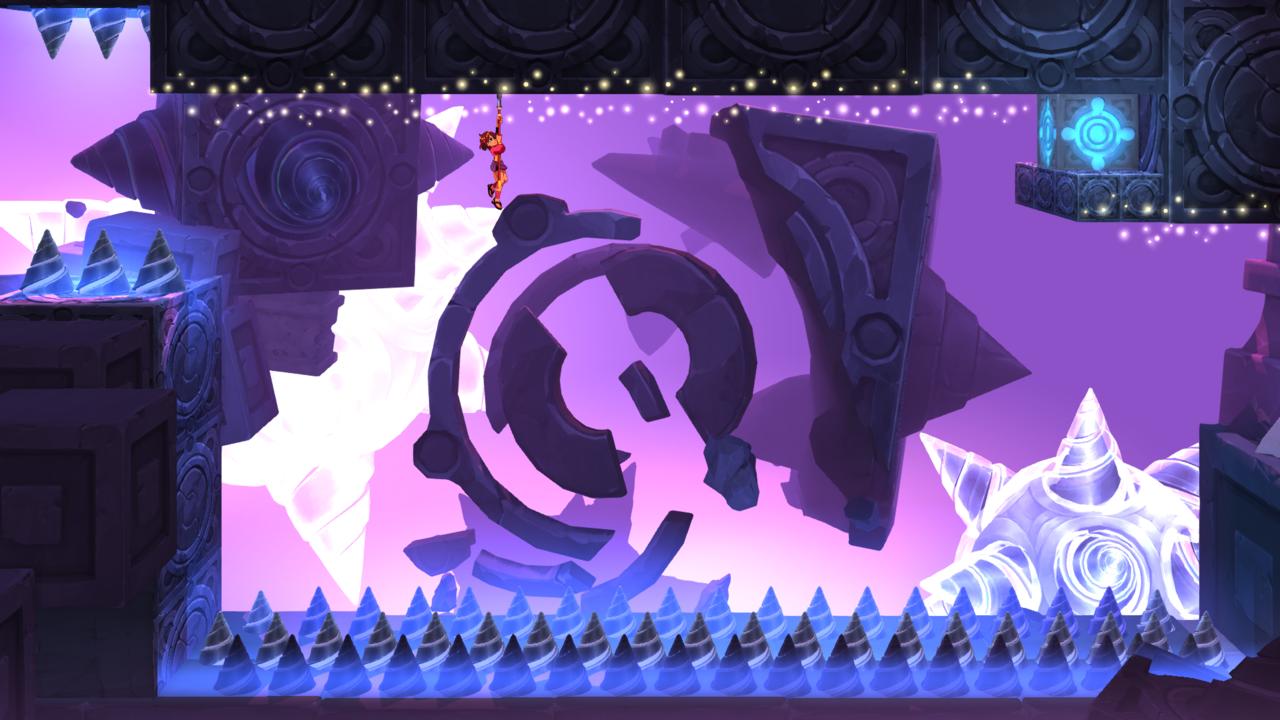There's nothing quite like the bright, beautiful, and sometimes distraught world of Indivisible. It's one that wears its Southeast/South Asian influences on its sleeve, and pulls you into places you want to be in with characters you want to be around. Developer Lab Zero blends several genre elements to create a system of combat and platforming that flows seamlessly between Indivisible's seemingly disparate parts. It has so much going for it that it's disappointing when heartfelt exchanges and pivotal moments lack the gravitas they deserve or are simply glossed over. While Indivisible has trouble following through narratively, I can't shake its enjoyable moments and the sense of cultural visibility it gives a region I'm connected to.
Your journey across Indivisible's world revolves around Ajna, the hard-headed but full-hearted protagonist who perpetually stumbles into revelations about her true nature. She makes new friends along the way who either have mutual goals in mind or don't need much convincing to join her cause. Other than brief surprise, no one seems to bat an eye at the fact that they get physically absorbed into Ajna's consciousness--a separate plane of existence that acts as a sort of hub area--only to be summoned in battle or in conversation. You'll have to concede having deeper explanations other than Ajna's supernatural powers and third-eye chakra which are connected to the ominous villain Kala, goddess of destruction and creation.

Although a handful of key characters are central to the story, you assemble a party of four from a large and varied roster that's built up rather quickly. You assign a party member to a position in combat that corresponds with a face button; this is how you actively send them in to deal damage in real-time during an offensive phase and have them individually defend when enemies initiate attacks. Getting the hang of Indivisible's hybrid of turn-based and real-time mechanics opens you up to inventive ways of combining different characters' movesets and timing their specific attacks at the right time. It's easy to see how Lab Zero channels elements of its previous game, Skullgirls--there's a slight fighting game touch with combos, directional attacks, guard breaks, perfect blocks, and air juggling attacks. You also build up a meter, called Iddhi, which represents Ajna and friends' ability to go into overdrive for executing powerful special attacks. Battles tend to move fast, and this layered combat system makes you eager to get into the next fight.
It's not necessary to learn every character as it's viable to stick with a handful of your favorites to cycle between for certain situations (they all level alongside Ajna so no one gets left behind). But as great as combat can be, you'll be disappointed to know that its wonderful complexities are squandered by a lack of challenge towards the end of the game. Your party becomes so powerful that simple button mashing will get you by most, if not all, enemies and bosses. You'll continually recruit new members in the late-game, too, but with little reason to get in tune with their mechanics. Combat's biggest enemy is the lack of difficulty right when the stakes should be the highest.
Fighting is only half of Indivisible, gameplay-wise, though--it's partly a 2D side-scrolling adventure that draws from Metroidvania-style exploration. As you accumulate new tools and powers, so too does your means of traversal. Ajna starts with an axe that she uses to propel herself upward to higher ledges, but she'll soon be pole-vaulting, pogo-sticking, and monkey-swinging with a spear to avoid hazards and reach new areas. Her own superpowers eventually let you dash across wide gaps, jump to greater heights, and break through walls. What makes all these mechanics fun to use is that you face a variety of obstacles that force you to think about the clever ways you need to string together your toolset and abilities to overcome these platforming challenges.
Unlike combat, platforming steadily ramps up to a satisfying difficulty towards the end, but it's never frustrating since you only face light punishment for death. Rather than loading a previous save, you get brought back to a generously placed checkpoint should you fail a sequence. What's more, a number of boss battles merge the two gameplay styles and test you to juggle both at a rapid pace. That could sound like the game biting off more than it can chew, but the pace at which you transition between the two phases keep things moving seamlessly.
From one location to another, Indivisible's imaginative art style gives you an unmistakable sense of where you are and the things that happen there. I'm still thinking about the rough streets of Tai Krung City, which come to life through neon signage, quirky apartment setups, lavish clubs, and sketchy alleyways. Even the grimy, oppressive Iron Kingdom clearly communicates a hardship among the common folk who inhabit the cobblestone roads, and you feel the bustle of the markets that occupy the colorful seaside town of Port Maerifa. That rich sense of style extends to each of the characters, who are beautifully realized in expressive, hand-drawn artwork. It's an evolution of the imaginative style and designs from Skullgirls, and it helps distinguish each member of the wide, diverse cast.

Indivisible's sensational soundtrack tops off the joy of exploration and complements the feelings you get from soaking in the beautiful visuals. The infectious tunes solidify the personality of Indivisible's locations, a favorite among the tracks being the song that plays in Tai Krung City--its steel drums and upstroke guitar riffs hook you, but its somber melody reflects the town's dreary side. And the energetic tempo and horn section of the club area's song propels you to keep going, especially when it doubles as the battle theme. The Pacific Islander-influenced region of Kaanul features a theme with catchy woodwind instrumentation and a solemn string section. Indivisible's soundtrack is very much part of the atmosphere it aims to build, and it's one that's worth listening to on its own.
I want to love Indivisible unconditionally; it has so many great pieces, and it's a special thing to feel seen. I'm happy to have a game that's distinctly Southeast Asian, giving some earnest representation to a part of the world I belong to and one I'm even more curious about now.
Indivisible roots itself in broad-reaching concepts from Southeast/South Asian mythologies and history. Every in-game region's introduction is written in Sanskrit. Mount Sumeru, the critical location for which Indivisible starts and concludes, is derived from the sacred mountain in Hindu, Buddhist, and Jain mythology that harnesses all things physical and spiritual. An important character, Thorani, who treats Ajna as one of her own, calls her luksao, the Thai word for daughter. You can also spot smaller pop culture references, too--special shout out to the Jollibee reference in Tai Krung City, and a charming wannabe-Kamen Rider stand-in. Even down to character names, there are so many more connections to draw. While Indivisible doesn't necessarily explore these cultures in any particular depth or in more meaningful ways, it gives the stage to a diverse region to tell a simple story of personal growth, self-acceptance, and sacrifice.

With that said, while Indivisible has the foundation to portray something powerful it doesn't exactly follow through. Many of Indivisible's major story beats lack the necessary impact they need to stick with you and get you fully invested in Ajna's fight to save the world. While there's an assortment of likeable personalities and quips between characters, and the voice acting performances shine, many dialogue sequences don't reflect the gravity of the situations that unfold. For example, Ajna internalizes life-altering events in ways that frame them as frustrations to her rather than tragedies. And when she inadvertently causes destruction, it's largely brushed off as an accident with consequences that aren't communicated. Characters are quick to change their minds about things without portraying the process through which they came to their conclusions, undermining possible emotional stakes.
There are key moments when other characters push back and confront others to think harder about what they're doing. Whether it's characters who open themselves up to feel any sort of positive emotion, go through a sincere redemption arc, or provide unquestioning support, you can identify the times Indivisible gets it right. I can't help but wish that the story contained these highlights more often than not.
I want to love Indivisible unconditionally; it has so many great pieces, and it's a special thing to feel seen. I'm happy to have a game that's distinctly Southeast Asian, giving some earnest representation to a part of the world I belong to and one I'm even more curious about now. As a whole, it sometimes doesn't come together; it's missing weight to its narrative and the challenges necessary to flex its wonderful combat system. But it stands out as an RPG that's doing something genuinely different, and it brings joy to its clever platforming with the tune of an infectious soundtrack. For all its faults, Indivisible has its heart in the right place.



















